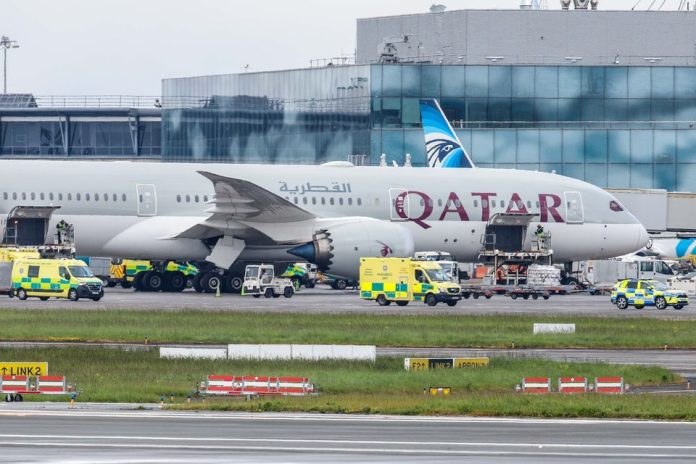Twelve people were injured after a Qatar Airways flight from Doha to Dublin encountered severe turbulence on Sunday. The affected flight, QR017, landed safely in Dublin just before 1 pm local time and was met by emergency services, including airport police and the fire and rescue department.
According to a statement from Dublin Airport, six passengers and six crew members were injured in the incident. Eight of the injured individuals were taken to the hospital following an initial assessment. The turbulence occurred while the aircraft was flying over Turkey.
Despite the incident, Dublin Airport reported that it was assisting passengers and staff effectively and that airport operations remained unaffected. The return flight to Doha, QR018, is scheduled to proceed as planned, albeit with a delay.
Qatar Airways issued a statement to Media confirming the safe landing of the flight in Dublin and acknowledging that a small number of passengers and crew sustained minor injuries. “The matter is now subject to an internal investigation,” the statement added. “The safety and security of our passengers and crew are our top priority.”
This incident follows closely on the heels of another severe turbulence event involving a Singapore Airlines flight. On Tuesday, Flight SQ321 from London to Singapore experienced significant turbulence at 37,000 feet, resulting in 104 passengers being injured and a man with a heart condition succumbing to the strain. This flight experienced sharp altitude changes and turbulence likely linked to developing thunderstorms in the area.
Such incidents highlight the prevalence of turbulence in aviation. In the United States alone, approximately 65,000 aircraft encounter moderate turbulence annually, with about 5,500 encountering severe turbulence. These figures could potentially increase, according to experts.
Paul Williams, a professor of atmospheric science at the University of Reading in the United Kingdom, indicated in a 2022 interview with CNN that climate change might be exacerbating turbulence. “We ran some computer simulations and found that severe turbulence could double or triple in the coming decades,” Williams said. These findings, corroborated by observations, particularly pertain to “clear air turbulence,” a type that occurs without any visual indicators like storms or clouds and strikes suddenly, making it particularly hazardous.
The nature of the turbulence experienced by the Qatar Airways flight is still unknown, pending further investigation. This incident underscores the unpredictable and potentially increasing nature of turbulence in air travel, necessitating ongoing vigilance and preparedness from airlines and aviation authorities.


